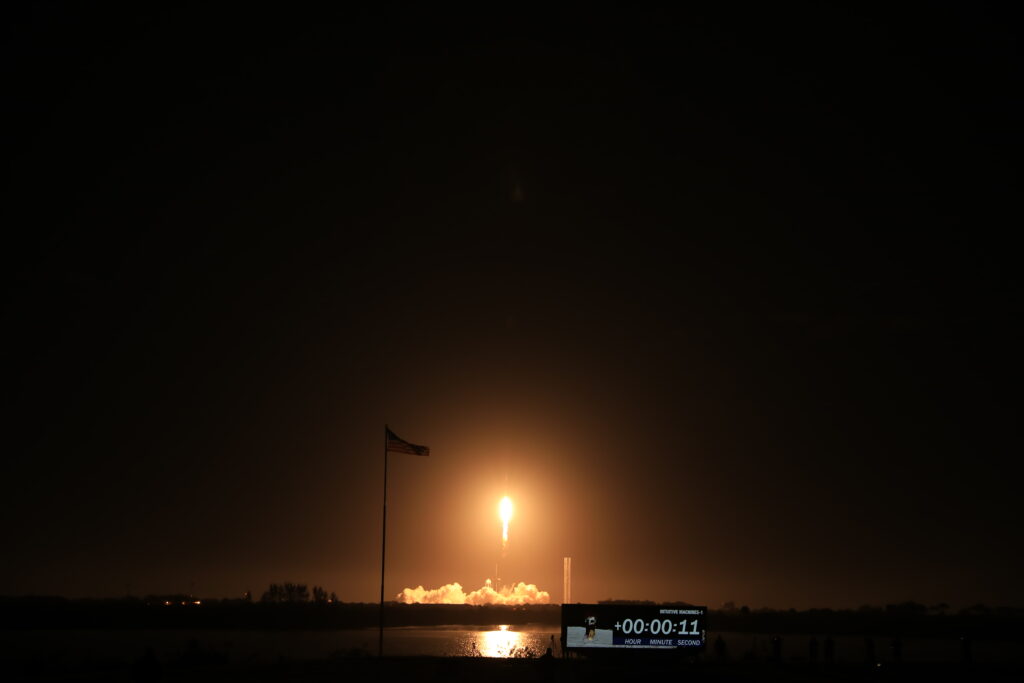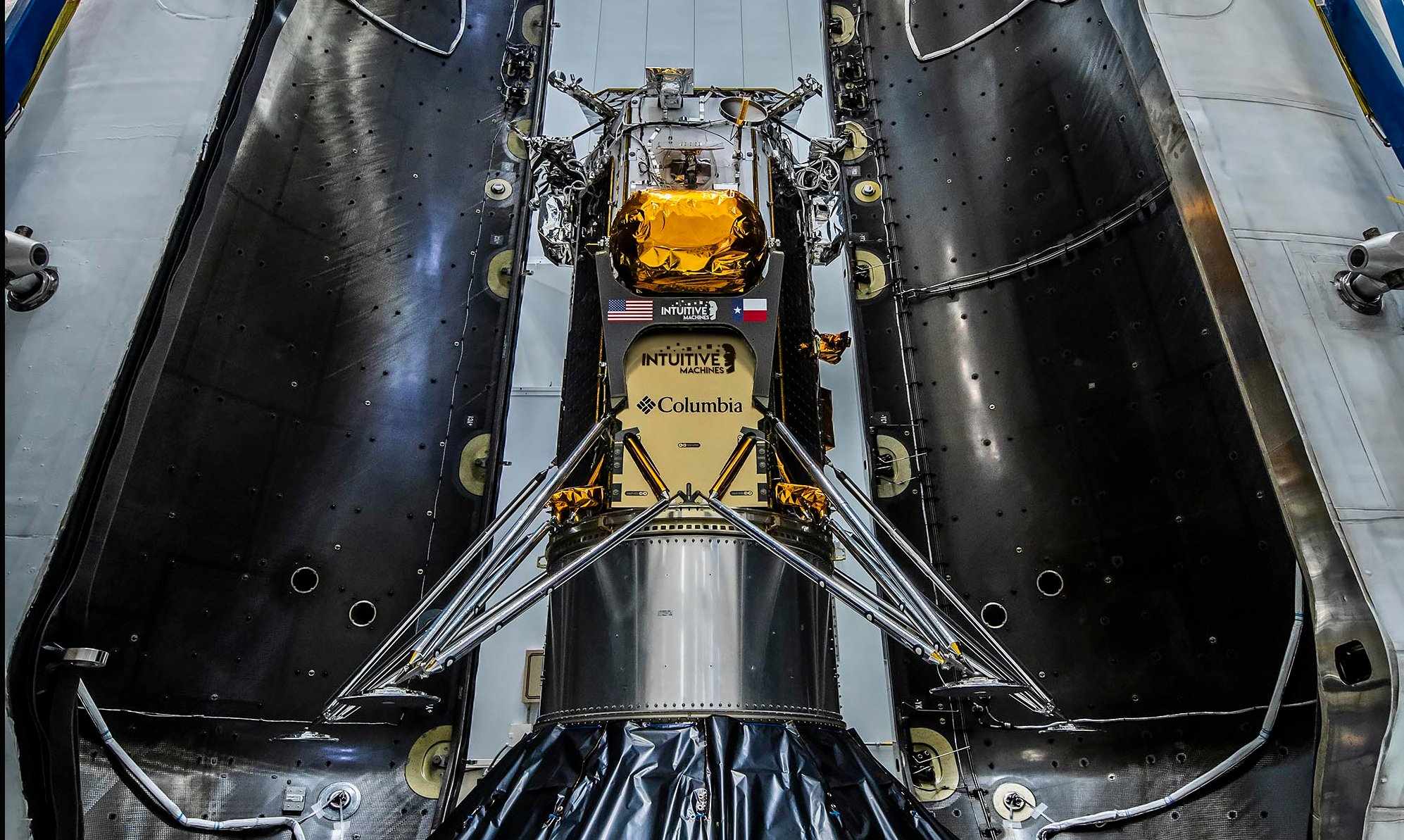
Intuitive Machines’ IM-1 spacecraft is en-route to the Moon tonight, following a spectacular 1:05 a.m. EST Thursday launch atop a SpaceX Falcon 9 booster from historic Pad 39A at Florida’s Kennedy Space Center (KSC). The ambitious mission, which carries a group of scientific research instruments from NASA and academia, together with the first piece of sculptural artwork destined for another world, is flying under the Commercial Lunar Payload Services (CLPS) contract and, if successful, will become the first U.S. spacecraft to soft-land on the surface of our closest celestial neighbor since Apollo 17 in December 1972.
IM-1 於美國東部時間週四凌晨 1 點 05 分在佛羅裡達州午夜後的黑暗中發射。照片來源:NASA/Mike ChambersIntuitive Machines 的IM-1 太空船今晚正在前往月球的途中,美國東部時間週四凌晨1:05 借助SpaceX Falcon 9 助推器從佛羅裡達州肯尼迪航天中心(KSC) 具有歷史意義的39A 發射台進行了一次壯觀的發射。這項雄心勃勃的任務攜帶了一組來自美國宇航局和學術界的科學研究儀器,以及第一件運往另一個世界的雕塑藝術品,正在根據商業月球有效載荷服務(CLPS)合約進行飛行,如果成功,將成為這是自 1972 年 12 月阿波羅 17 號以來第一艘在我們最近的天體鄰居表面軟著陸的美國太空船。
Originally scheduled to launch at 12:57 a.m. EST Wednesday, SpaceX teams elected to postpone to Thursday’s backup opportunity, citing “off-nominal methane temperatures” as they prepared to load IM-1’s Nova-C lunar lander (named “Odysseus” in honor of the ancient hero of the Trojan War) with liquid methane propellant. That resulted in two other Falcon 9 missions on the East and West Coasts—the first carrying the U.S. Space Force’s highly classified USSF-124 payload from storied Space Launch Complex (SLC)-40 at Cape Canaveral Space Force Station, Fla., the second a batch of 23 Starlink low-orbiting internet communications satellites from SLC-4E at Vandenberg Space Force Base, Calif.—leapfrogging IM-1, targeting their own launches on Wednesday afternoon.
原定於美國東部時間週三凌晨12:57 發射的SpaceX 團隊選擇推遲到週四的備份機會,理由是“甲烷溫度超出標稱”,因為他們準備裝載IM-1 的Nova-C 月球著陸器(命名為「奧德修斯」以紀念特洛伊戰爭古代英雄的肖像)與液態甲烷推進劑。這導致獵鷹9 號在東海岸和西海岸執行了另外兩次任務,第一次是從佛羅裡達州卡納維拉爾角太空部隊站著名的太空發射綜合體(SLC)-40 運載美國太空軍高度機密的USSF-124 有效載荷,第二次是從佛羅裡達州卡納維拉爾角太空部隊站著名的太空發射綜合體(SLC)-40加利福尼亞州范登堡太空部隊基地的SLC-4E 發射了一批次23 顆星鏈低軌道網路通訊衛星,超越了IM-1,目標是在周三下午自行發射。
The result could have produced a pair of launches a record-setting 120 minutes apart, creating a pair of lovers’ candles on both U.S. seaboards for Valentine’s Day, but it was not to be. USSF-124 took flight right on time at 5:30 p.m. EST and emplaced six payloads into low-Earth orbit: two Hypersonic and Ballistic Tracking Space Sensor (HBTSS) satellites for the Missile Defense Agency (MDA) and the final four Tranche 0 Transport and Tracking Layer (TTL) satellites for the Space Development Agency (SDA).
結果本可以創造兩次相隔 120 分鐘的發射,在情人節那天在美國兩個沿海地區創造出一對情人蠟燭,但事實並非如此。 USSF-124 準時在下午 5:30 起飛。 EST 並將六顆有效載荷部署到近地軌道:飛彈防禦局(MDA) 的兩顆高超音速和彈道追蹤空間感測器(HBTSS) 衛星以及太空發展局的最後四顆Tranche 0 傳輸和追蹤層(TTL)衛星 ( SDA)。
All six payloads “were safely delivered to their intended orbit”, noted Space Systems Command (SSC) in an update shortly after last night’s USSF-124 launch. “We’re proud to support both the MDA and the SDA with this co-manifested National Security Space Launch,” said Col. Jim Horne, senior materiel leader for SSC’s Launch Execution Delta. “We’ve worked side-by-side with our launch service provider and space vehicle partners to achieve the mission on-time and with precision.”
太空系統司令部 (SSC) 在昨晚 USSF-124 發射後不久的更新中指出,所有六個有效載荷「均已安全送達預定軌道」。 SSC 發射執行三角洲高級物資負責人 Jim Horne 上校表示:“我們很自豪能夠通過這次聯合的國家安全太空發射來支持 MDA 和 SDA。” “我們與發射服務提供者和太空船合作夥伴並肩工作,以按時、精確地完成任務。”
USSF-124 rose to orbit atop B1078, a Falcon 9 booster introduced to the fleet last March and making her seventh flight. “We’re reaping the benefits of this innovation with every launch,” said Dr. Walt Lauderdale, SSC’s Assured Access to Space (AATS) mission director. “As we move forward together with SpaceX, we’re methodically expanding reuse to leverage the benefits for the USSF and our space vehicle teammates.
USSF-124 搭乘 B1078(去年 3 月引入艦隊的獵鷹 9 號助推器)升入軌道,並進行了第七次飛行。 「每次發射,我們都從這項創新中獲益,」SSC 的太空保障 (AATS) 任務主任沃爾特·勞德代爾 (Walt Lauderdale) 博士說。 「當我們與 SpaceX 共同前進時,我們正在有條不紊地擴大重複利用,以便為 USSF 和我們的太空船隊友帶來好處。
“The mission team was able to add the Tranche 0 satellites to USSF-124 in under 30 days, less than six months from the then-scheduled launch date,” Dr. Lauderdale continued. “This unprecedented responsiveness is a needed capability for the Space Force to confront today’s threat environment.”
「任務團隊能夠在 30 天內將 Tranche 0 衛星添加到 USSF-124,距離當時預定的發射日期不到六個月,」勞德代爾博士繼續說道。 “這種前所未有的響應能力是太空軍應對當今威脅環境所需的能力。”
Attention then turned to Vandenberg, where the once-flown B1082 booster stood primed at SLC-4E with a payload of 22 Starlink internet communications satellites weighing in at 38,800 pounds (17,600 kilograms). A liftoff at the opening of this mission’s “launch window” at 4:30 p.m. PST (7:30 p.m. EST) would have produced a new empirical record of exactly two hours between pairs of Falcon 9 missions, eclipsing SpaceX’s prior personal best of two hours and 54 minutes set late last December.
隨後注意力轉向范登堡,曾經飛過的 B1082 助推器在 SLC-4E 上進行了啟動,有效載荷為 22 顆星鍊互聯網通信衛星,重達 38,800 磅(17,600 公斤)。下午 4:30 在本次任務「發射視窗」開啟時升空。太平洋標準時間(美國東部時間晚上7:30)將創造新的經驗記錄,獵鷹9 號任務之間的間隔恰好為兩小時,超過了SpaceX 去年12 月底創下的2 小時54 分鐘的個人最佳紀錄。
 Intuitive Machines’ IM-1 Odysseus lander is readied for encapsulation inside the Falcon 9 payload fairing for launch. Photo Credit: SpaceX
Intuitive Machines’ IM-1 Odysseus lander is readied for encapsulation inside the Falcon 9 payload fairing for launch. Photo Credit: SpaceXHowever, shortly after the USSF-124 launch, SpaceX noted on its website that it was tracking a T-0 later in the evening, aiming for 5:34 p.m. PST (8:34 p.m. EST), only 20 minutes shy of the closure of Wednesday’s “window”. Ultimately, the mission was stood down and realigned for a four-hour backup window that opens at 1:34 p.m. PST and closes at 5:33 p.m. PST Thursday.
Intuitive Machines 的 IM-1 Odysseus 著陸器已準備好封裝在 Falcon 9 有效載荷整流罩內以便發射。圖片來源:SpaceX然而,在 USSF-124 發射後不久,SpaceX 在其網站上指出,它正在晚上晚些時候跟踪一架 T-0,目標是下午 5:34。太平洋標準時間(美國東部時間晚上 8:34),距離週三「窗口」關閉僅剩 20 分鐘。最終,該任務被擱置,並重新安排了一個四小時的備份窗口,該窗口於下午 1:34 開啟。 PST 並於下午 5:33 關閉太平洋標準時間週四。
As this apparent “game” of rocket musical chairs played out, attention returned to the Space Coast and Intuitive Machines’ IM-1 mission. As previously detailed by AmericaSpace, IM-1’s Nova-C Odysseus lander aims to touch down on 22 February near Malapert-A, a 15-mile-wide (24-kilometer) “satellite crater” of the three-times-bigger Malapert impact basin near the Moon’s South Pole at 80.4 degrees South lunar latitude.
隨著這場明顯的火箭音樂椅「遊戲」的結束,人們的注意力又回到了太空海岸和直覺機器公司的 IM-1 任務上。正如AmericaSpace 先前詳細介紹的那樣,IM-1 的Nova-C Odysseus 著陸器計劃於2 月22 日在Malapert-A 附近著陸,Malapert-A 是一個15 英里寬(24 公里)的“衛星隕石坑”,是馬拉珀特撞擊事件的三倍大位於月球南緯 80.4 度的月球南極附近的盆地。
It will bring to the lunar surface a dozen payloads from NASA, the International Lunar Observatory (ILO), the University of Colorado at Boulder, Embry-Riddle Aeronautical University, Louisiana State University and others for the first U.S. soft-landing on our closest celestial neighbor since Apollo 17 in December 1972. IM-1’s chance at achieving that goal has been rendered newly possible following the disappointing loss of Astrobotic’s Peregrine lander, which suffered a catastrophic propellant leak shortly after launch in January and—though it attained lunar distance—was unable to make it to the surface.
它將把來自美國宇航局、國際月球觀測站(ILO)、科羅拉多大學博爾德分校、安柏里德爾航空大學、路易斯安那州立大學和其他機構的十幾個有效載荷帶到月球表面,以實現美國在我們最近的天體上的首次軟著陸自1972 年12 月阿波羅17 號以來,IM-1 就成為了近鄰。在Astrobotic 的Peregrine 著陸器令人失望地損失之後,IM-1 實現這一目標的機會再次成為可能。該著陸器在1 月發射後不久就遭遇了災難性的推進劑洩漏,儘管它到達了月球距離,但無法到達表面。
IM-1’s suite of payloads includes six instruments from NASA: an array of laser retroreflectors and a sophisticated navigational lidar for precise ranging, a lighthouse-like navigation demonstrator, an investigation into how well future Moon-based radio observatories might function on the Moon, an experiment to explore the response of lunar regolith to rocket exhaust and an innovative propellant mass gauge.
IM-1 的有效載荷套件包括來自NASA 的六種儀器:一系列雷射後向反射器和用於精確測距的精密導航雷射雷達、一個類似燈塔的導航演示器、對未來月球射電天文台在月球上運行情況的調查,一項探索月球風化層對火箭排氣和創新推進劑質量計響應的實驗。
Also aboard is Embry-Riddle University’s EagleCam CubeSat, which will be ejected shortly before IM-1 touches down, hopefully to acquire the first third-person views of a lunar landing. Louisiana State University has supplied its Tiger Eye-1 radiation monitoring instrument and the ILO-X experiment will evaluate precursor technology for a future planned astrophysics observatory for emplacement near the Moon’s South Pole.
搭載的還有安柏瑞德大學 (Embry-Riddle University) 的 EagleCam CubeSat,它將在 IM-1 著陸前不久彈出,有望獲得登月的第一個第三人稱視角。路易斯安那州立大學提供了 Tiger Eye-1 輻射監測儀器,ILO-X 實驗將評估未來計劃在月球南極附近建立天文物理觀測站的前驅技術。
Rounding out the IM-1 payload suit is Moon Phases, a set of sculptures created by award-winning artist Jeff Koons. It stands to become the first artwork of its kind to reach the lunar surface since Apollo 15 Commander Dave Scott left the “Fallen Astronauts” memorial in the dust of Hadley-Apennine in August 1971.
IM-1 有效載荷套裝的最後一個部分是月相,這是由屢獲殊榮的藝術家 Jeff Koons 創作的一組雕塑。這將成為自1971 年8 月阿波羅15 號指揮官戴夫·斯科特(Dave Scott) 將“陣亡宇航員”紀念碑留在哈德利-亞平寧的塵埃以來,首個抵達月球表面的同類藝術品。
Weather conditions for last night’s IM-1 launch were highly favorable, with a 95-percent Probability of Go (PGo). Fueling of the Nova-C lander got underway at 2.5 hours prior to liftoff, leveraging the skills of the Starship team whose primary propellant is liquid methane. “This is a first for using methane on the Falcon 9,” SpaceX tweeted, “so the Falcon team was able to lean on the Starship team’s expertise in this area to prepare for this mission.”
昨晚 IM-1 發射的天氣條件非常有利,成功機率 (PGo) 為 95%。 Nova-C 登陸器的燃料在升空前 2.5 小時開始,利用主要推進劑是液態甲烷的 Starship 團隊的技能。 SpaceX 發推文稱:“這是獵鷹 9 號首次使用甲烷,因此獵鷹團隊能夠依靠 Starship 團隊在該領域的專業知識來為這次任務做好準備。”
It proved a complex process, as a new fueling infrastructure and procedures needed to be developed to load the liquid methane aboard IM-1 whilst fully encapsulated inside the Falcon 9’s bulbous payload fairing on the pad. Shortly after the completion of methane tanking, at T-35 minutes the SpaceX Launch Director approved the loading of liquid oxygen and a highly refined form of rocket-grade kerosene (known as “RP-1”) aboard the Falcon 9 itself.
事實證明這是一個複雜的過程,因為需要開發新的燃料基礎設施和程序來將液態甲烷裝載到 IM-1 上,同時完全封裝在發射台上 Falcon 9 的球狀有效載荷整流罩內。甲烷儲槽完成後不久,在 T-35 分鐘時,SpaceX 發射總監批准在獵鷹 9 號火箭上裝載液態氧和高度精煉的火箭級煤油(稱為「RP-1」)。
Flying IM-1 on the first leg of its multi-day trek to the Moon was B1060, the fourth SpaceX vehicle to log an 18th launch. Powering smoothly out of the Space Coast at 1:05 a.m. EST, its nine Merlin 1D+ engines burned for 2.5 minutes, before the core stage separated and commenced a descent to alight on solid ground at Landing Zone (LZ)-1 at Cape Canaveral, the second such landing in 7.5 hours which set a new record for back-to-back touchdowns of single-stick Falcon 9s on solid ground, greatly surpassing the 41 hours which elapsed between two landings at the Cape and Vandenberg last November.
B1060 是 IM-1 多日登月旅程第一站的飛行器,也是 SpaceX 第 18 次發射的第四艘太空船。美國東部時間凌晨1 點05 分,其九台Merlin 1D+ 發動機順利駛離太空海岸,燃燒了2.5 分鐘,然後核心級分離並開始下降,降落在卡納維拉爾角著陸區(LZ)-1 的堅實地面上。這是7.5 小時內的第二次著陸,創造了單桿獵鷹9 號在固體地面上連續著陸的新紀錄,大大超過了去年11 月在海角和范登堡兩次著陸之間的41 小時。
With B1060 gone, the Falcon 9’s second stage conducted a pair of “burns” of its single Merlin 1D+ Vacuum engine: an initial six-minute pulse, followed by a 34-minute-long period of “coasting” and a second burn, lasting 53 seconds, ahead of deployment of IM-1 at 1:53 a.m. EST, some 48 minutes and 24 seconds into the mission. “Deployment of @Int_Machines IM-1 confirmed,” tweeted SpaceX as the six-legged lander drifted serenely away into the inky blackness to begin her week-long voyage to the Moon.
B1060 消失後,獵鷹9 號的第二級對其單一Merlin 1D+ 真空引擎進行了兩次「燃燒」:最初的6 分鐘脈衝,隨後是34 分鐘長的「滑行」期和第二次燃燒,持續時間比美國東部時間凌晨 1 點 53 分部署 IM-1 提前了 53 秒,即執行任務約 48 分 24 秒。 「@Int_Machines IM-1 的部署已得到確認,」SpaceX 在推特上寫道,此時六足著陸器靜靜地駛入漆黑的夜空,開始為期一周的月球航行。


 TheNewsCrypto
TheNewsCrypto TheNewsCrypto
TheNewsCrypto DogeHome
DogeHome Crypto Daily™
Crypto Daily™ Crypto Daily™
Crypto Daily™ Crypto Daily™
Crypto Daily™ Optimisus
Optimisus CoinsProbe
CoinsProbe CryptoNewsLand
CryptoNewsLand






















